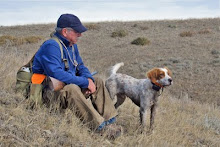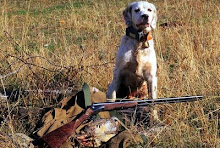
Mark Copeland removes cactus thorns from his GSP, Princess
Although I have a pair of Lewis dog boots in my kit somewhere, I cannot recall ever using them. My dogs have developed pretty tough feet, and learned to avid the worst of the cactus and thorns. But they are not bullet proof. Whether you boot or not, your dog will end up with cactus punctures if you run in the Southwest.
The most common thorns they encounter where I hunt are hawthorn, mesquite, cholla cactus (at the rear of my friend Mark) and prickly pear cactus (foreground of photo). The cholla - they are found across the Southwest, and there are perhaps 20 different types - are nasty because they are clumpy with many fine thorns. They hit the dog, stick to the fur, and break off in clumps. They are often lodged tight to the dog's coat on the belly or under a leg. The dog who runs into a cholla may stop altogether and await your help. I carry a Leatherman tool on my belt to pull cholla balls off them and to remove the worst of the thorns.
This past season in West Texas, the rains had created a luxuriant growth of grass, with many prickly pear cactus hidden below. The dogs had a tough time getting through the grass in places, and the prickly pear cactus offered a nasty surprise with inch long thorns waiting for a misstep.
Maintenance means checking the dogs every 30 to 60 minutes when watering, whenever they stop or limp, and certainly when you arrive back at the vehicle before they go into their crate. Remove all possible thorns. Between the toes is a vulnerable area, and sensitive. If your dog is snappy, put a jacket over his head and tie the sleeves under his chin. A pair of hemostats in your kit will help to get the fine, hair-like barbs that always seem to end up in the front of the chest and legs. Also check the tongue and muzzle area. I think little antiseptic is a good idea before you put your dog up. If his feet are really tender, keep looking for the cause, and give the little warrior a day off.
After the trip I check each dog closely for tiny red bumps in the skin - each of them will have a tiny barb that can be removed with a tweezers, and I apply antiseptic to these after pulling the thorns. It may take several sessions over a couple days to get them all out.









2 comments:
Amen! Very well said Mike!
While we definitely don't have spiny, nasty things like cactus up in the northeast, I still like to spray my dogs undercarriage with a very dilute Novalsan (disinfectant) solution to minimize irritations and scratches from either grasses or thorns.
A.
Post a Comment